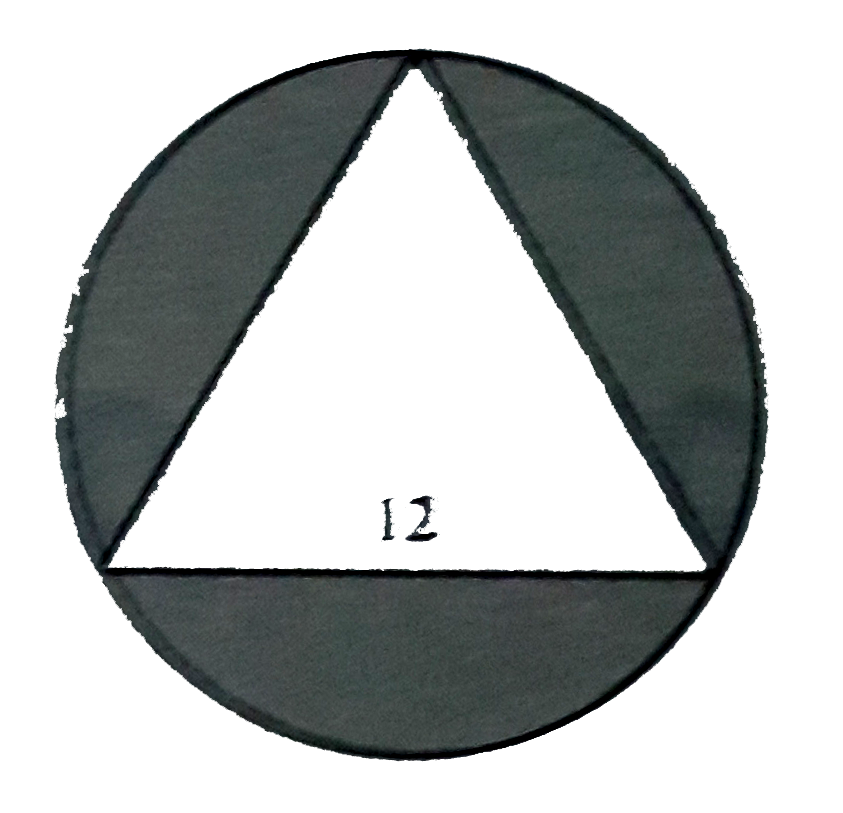In an equilateral triangle of side 3 cm , a circle is inscribed in which again an equliateral triagle is
inscribed and so on . This continues for an infinite
number of times . Then
Sum of areas of all circles (in cm2)is√3π
Sum of areas of all circles (in cm2)isπ
Sum of areas of all equilateral triangles (in cm2) is 3√3
Sum of areas of all equilateral triangles (in cm2)iss√3
The correct Answer is:2,3
To solve the problem step by step, we will find the area of the infinite series of inscribed equilateral triangles and circles within the original triangle of side 3 cm.
Step 1: Find the radius of the inscribed circle in the original triangle.
For an equilateral triangle, the radius r of the inscribed circle can be calculated using the formula:
r=a√36
where a is the side length of the triangle.
Given a=3 cm:
r=3√36=√32 cm
Hint: Remember that the radius of the inscribed circle in an equilateral triangle is derived from its side length.
Step 2: Find the side length of the first inscribed triangle.
The side length s1 of the triangle inscribed in the circle can be calculated using the formula:
s1=2rsin(60∘)
Substituting r=√32:
s1=2(√32)⋅√32=32 cm
Hint: Use the sine of 60 degrees, which is √32, to find the side length of the triangle inscribed in the circle.
Step 3: Find the side lengths of subsequent triangles.
The side lengths of the triangles form a geometric sequence:
- First triangle: s1=3
- Second triangle: s2=32
- Third triangle: s3=34
- Fourth triangle: s4=38
- And so on...
The general term for the side length of the n-th triangle is:
sn=32n−1
Hint: Recognize the pattern in the side lengths; they decrease by half for each subsequent triangle.
Step 4: Find the area of the triangles.
The area An of an equilateral triangle can be calculated using the formula:
An=√34s2n
Substituting sn=32n−1:
An=√34(32n−1)2=√34⋅94n−1=9√34n
Hint: Use the formula for the area of an equilateral triangle and substitute the expression for sn.
Step 5: Sum the areas of all triangles.
The total area of all triangles is given by the sum of an infinite geometric series:
A=∞∑n=1An=∞∑n=19√34n
This is a geometric series with first term a=9√34 and common ratio r=14:
A=a1−r=9√341−14=9√3434=3√3
Hint: Use the formula for the sum of an infinite geometric series to find the total area.
Final Result
The total area of all the inscribed equilateral triangles is:
Total Area=3√3 cm2
- Second triangle: s2=32
- Third triangle: s3=34
- Fourth triangle: s4=38
- And so on...
Topper's Solved these Questions
- SEQUENCES AND SERIES BOOK - AAKASH INSTITUTE ENGLISHCHAPTER - SEQUENCES AND SERIES EXERCISE - Assignment (SECTION - D) Linked Comprehension
11 Videos
- SEQUENCES AND SERIES BOOK - AAKASH INSTITUTE ENGLISHCHAPTER - SEQUENCES AND SERIES EXERCISE - Assignment (SECTION - E) Assertion-Reason
12 Videos
- SEQUENCES AND SERIES BOOK - AAKASH INSTITUTE ENGLISHCHAPTER - SEQUENCES AND SERIES EXERCISE - Assignment (SECTION - B) One option is correct
49 Videos
- RELATIONS AND FUNCTIONS BOOK - AAKASH INSTITUTE ENGLISHCHAPTER - RELATIONS AND FUNCTIONS EXERCISE - Assignment (Section - J) Aakash Challengers Questions
8 Videos
- SETS BOOK - AAKASH INSTITUTE ENGLISHCHAPTER - SETS EXERCISE - SECTION-I(Aakash Challengers Questions)
4 Videos
Similar Questions
Knowledge Check

An equilateral triangle with side 12 is inscribed in a circle . Find the shaded area .A12π−36√3B36π−48√3C36π−36√3D48π−36√3
Construct a circle, inscribing an equilateral triangle with side 5.6 cm.
View SolutionConstruct an equilateral triangle ABC with side 6 cm. Draw a circle circumscribing the triangle ABC.
View SolutionAn equilateral triangle is inscribed in a circle of radius 6cm. Find its side.
View SolutionShow that the triangle of maximum area that can be inscribed in a given circle is an equilateral triangle.
View SolutionShow that the triangle of maximum area that can be inscribed in a given circle is an equilateral triangle.
View SolutionA circle is inscribed in an equilateral triangle of side a. Find the area of any square inscribed in this circle.
View SolutionThe area of an equilateral triangle inscribed in a circle of radius 4cm, is
View Solution
